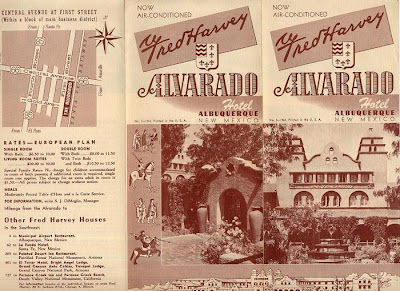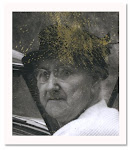This was actually going to be a very short post. I figured I’d take this week’s
Sepia Saturday (rain and umbrellas) in a different direction by providing you with some recent purchases taken in July, 1926 at the Cheyenne, Wyoming Round-up. My thinking, slow witted as I might be, was that I’d take you in the direction of a Native American rain dance. Then, as often happens, the little scraps of paper sent me on a journey. Plus, and this is a biggie, I figured out a way to take the black album stock off of photos that were torn from old albums. That tip to come, and not for the delicate minded.
Cheyenne is the capital of Wyoming, located in Laramie County. The
Cheyenne Frontier Days, which I’m guessing includes the Round-up, has been held each year since 1897. These photos, from 1926, are part of a group of shots showing a family vacation in the wilds of the West. There are several more photos from the series which I will feature over the next week. Today’s are specifically from the Round-up. All of the photos were developed and printed at the Elite Studio in Omaha, Nebraska.


 Click on images to see them larger.
Click on images to see them larger.
I do not know which tribe is being represented in this parade, but their clothing convinces me they were from the Plains. Indeed, they might actually be
Cheyenne.
Here is an article from the
August 11, 1923 Cape Girardeau Southeast Missourian newspaper detailing what you might have seen at one of these events.
 Click on article to see it larger or click on link above.
Click on article to see it larger or click on link above.
In this vintage snapshot you can see the grandstand the writer mentions in the article.
 Click on image to see it larger.
Click on image to see it larger.
On the back of this shot it says, “Pete Morrison and Buck Jones movie stars and other cowboys Cheyenne Round up 1926.” I cannot tell you which one is which in this shot.
 Click on image to see it larger.
Click on image to see it larger.

George D. Morrison, nicknamed Pete, was an American silent western film actor born August 8, 1890 in Westminster, Colorado. During his childhood he lived at Morrison, Colorado (named for his grandfather George Morrison) and Idaho Springs, and got his early tastes of horsemanship riding with his father Thomas during the summer. They drove cattle and sheep from the summer ranges in Middle Park and Fall River in Colorado to supply beef and mutton to the mining camps of Georgetown, Idaho Springs, Nevadaville, Black Hawk and Central City. During his mid-teens Pete worked in the mining industry, with his older brothers driving in sections of the Argo Tunnel where Pete was a motorman, hoist operator, topside helper, teamster hauler, assisting several of the larger miners in the Idaho Springs area. In the summer of 1910 Pete Morrison was an engine fireman for the Colorado Southern Railroad when he was lured away by the early western movies. Pete began working as a stunt man for the Essanay Studios of Broncho Billy films, soon discovering he could make more money working in movies in 2 weeks than he could make working for a month on the railroad. Pete followed his older brother Chick Morrison to California, where he also became a star in early western pictures. Through his career, Morrison transcended from very early film in 1909 to sound in 1935 starring in some 132 pictures. (SOURCE: Wikipedia)

Buck Jones (December 12, 1891 – November 30, 1942) was an American motion picture star of the 1920s, 1930s, and 1940s, best known for his work starring in many popular western movies. In his early film appearances, he was billed as Charles Jones.
Charles Frederick Gebhart was born on the outskirts of Vincennes, Indiana on December 12, 1891. (Some sources erroneously indicate December 4, 1889, but Jones's marriage license and his military records confirm the 1891 date.)[2] In 1907, Jones joined the US Army a month after his sixteenth birthday: his mother had signed a consent form that gave his age as eighteen. He was assigned to Troop G, 6th Cavalry Regiment, and was deployed to the Philippine islands in October, 1907, where he served in combat and was wounded during the Moro Rebellion. Upon his return to the U.S. in December, 1909, he was honorably discharged at Fort McDowell, California.
Following his military service, he began working as a cowboy on the 101 Ranch near Bliss, Oklahoma. While attending equestrian shows he met Odille "Dell" Osborne, who rode horses professionally. The two became involved, and married in 1915. Both had very little money, so the producers of a Wild West Show they were working on at the time offered to allow them to marry in an actual show performance, in public, which they accepted.
While in Los Angeles, and with his wife pregnant, Jones decided to leave the cowboy life behind and get a job in the film industry. He was hired by Universal Pictures for $5 per day as a bit player and stuntman. He later worked for Canyon Pictures, then Fox Film Corporation, eventually earning $40 per week as a stuntman. With Fox his salary increased to $150 per week, and company executive William Fox decided to use him as a backup to Tom Mix. This led to his first starring role, The Last Straw, released in 1920. (SOURCE: Wikipedia)
Here we have an old Buck Jones movie from 1931 which also includes a young John Wayne.
Then we get to the last shot which I find the most fascinating. On the back it says, “Bonnie Gray and famous horse Cheyenne 1926.” I did a bit of research online and in a book I have about cowgirls.

Click on image to see it larger.
 Bonnie Gray Harris
Bonnie Gray Harris (1891-1988)
Tall and athletic, Bonnie is best remembered for her amazing stunts and trick riding. Allegedly the first woman to perform the “under the belly crawl” on a horse, she also jumped her horse over an open car with passengers and was one of the first women to ride bulls in Mexican bullfights. As the movie industry flourished in California, so did Bonnie’s career as a stunt rider.
(SOURCE: National Cowgirl Museum and Hall of Fame)

The following are all from
Cowgirls: Women of the Wild West by Elizabeth Clair Flood.
 “If one loves a thing and does it well, why shouldn’t se do it?” said Bonnie Gray to her disapproving family. Her parents had high hopes for their daughter, who had a college degree in music and was a fine pianist. But Gray’s love for competitive sports lured her into the rodeo world of the Cheyenne Frontier Days, Oregon’s Pendelton Round-up, the Calgary Stampede, and New York’s Madison Square Garden.
“If one loves a thing and does it well, why shouldn’t se do it?” said Bonnie Gray to her disapproving family. Her parents had high hopes for their daughter, who had a college degree in music and was a fine pianist. But Gray’s love for competitive sports lured her into the rodeo world of the Cheyenne Frontier Days, Oregon’s Pendelton Round-up, the Calgary Stampede, and New York’s Madison Square Garden.
Bonnie Gray earned money jumping her horse King Tut over an automobile filled with passengers.

Despite the broken bones and the long hours on the road, many of the early cowgirls admitted that rodeo in the ‘teens and 1920s was glamourous. When asked what motivated her to live such hard life, Bonnie Gray answered: “Oh honey, I loved it. I was tops in the and tops in the that. I just loved being tops!”
Some cowgirls did make reasonable amounts of money. Bonnie Gray, who often substituted for cowboys Bing Crosby, Hoot Gibson, and Buck Jones, earned $10,000 for jumping a horse over a pile of brush and down a ten-foot cliff. The horse landed such that the stirrup straps broke and Gray sustained a backward fall. She commented that she would never do the stunt again, but few who knew her were convinced. “I used to ride to Beverly Hills and practice my stunts on Will’s (Will Rogers’s) front lawn," Gray said.

If I hadn’t figured out how to get the old black album paper off the back of this shot I’d have never known that this was one fascinating woman sitting astride that fabulous horse. To read a bit more about Bonnie Gray click
here. And I have listed two wonderful books about cowgirls in the Amazon column to the left. They're full of photos and ephemera making you wish you'd never thrown your old six-shooter and boots away...providing you remember those days as a kid.

Now, how did I get the paper off? Spit. Not kidding. Spit. I still remember a teacher at art college who told the class about the magic of spit and its various uses for artists. It has to do with the acidity in spit. So taking a chance I dabbed a small amount of spit on the back of the photo ever so lightly, let it sit for a few moments, then took an x-acto knife and gently scrapped off the paper. Remember, you heard it here. Spit. Will never be marketed by a corporation. We own it. And if you do this and it ruins your photo I take no responsibility. My spit might be different than yours.
And now, back to what started this post, the rain dance.



























































